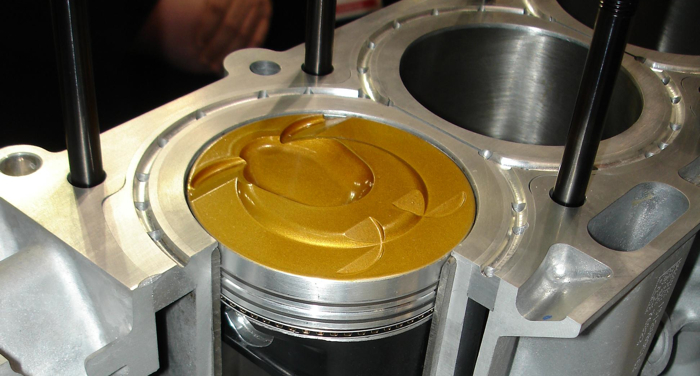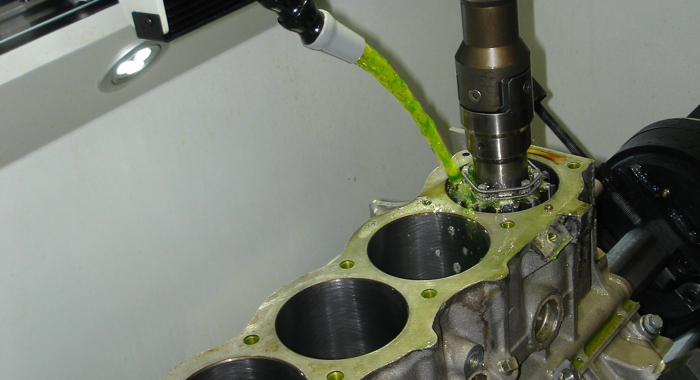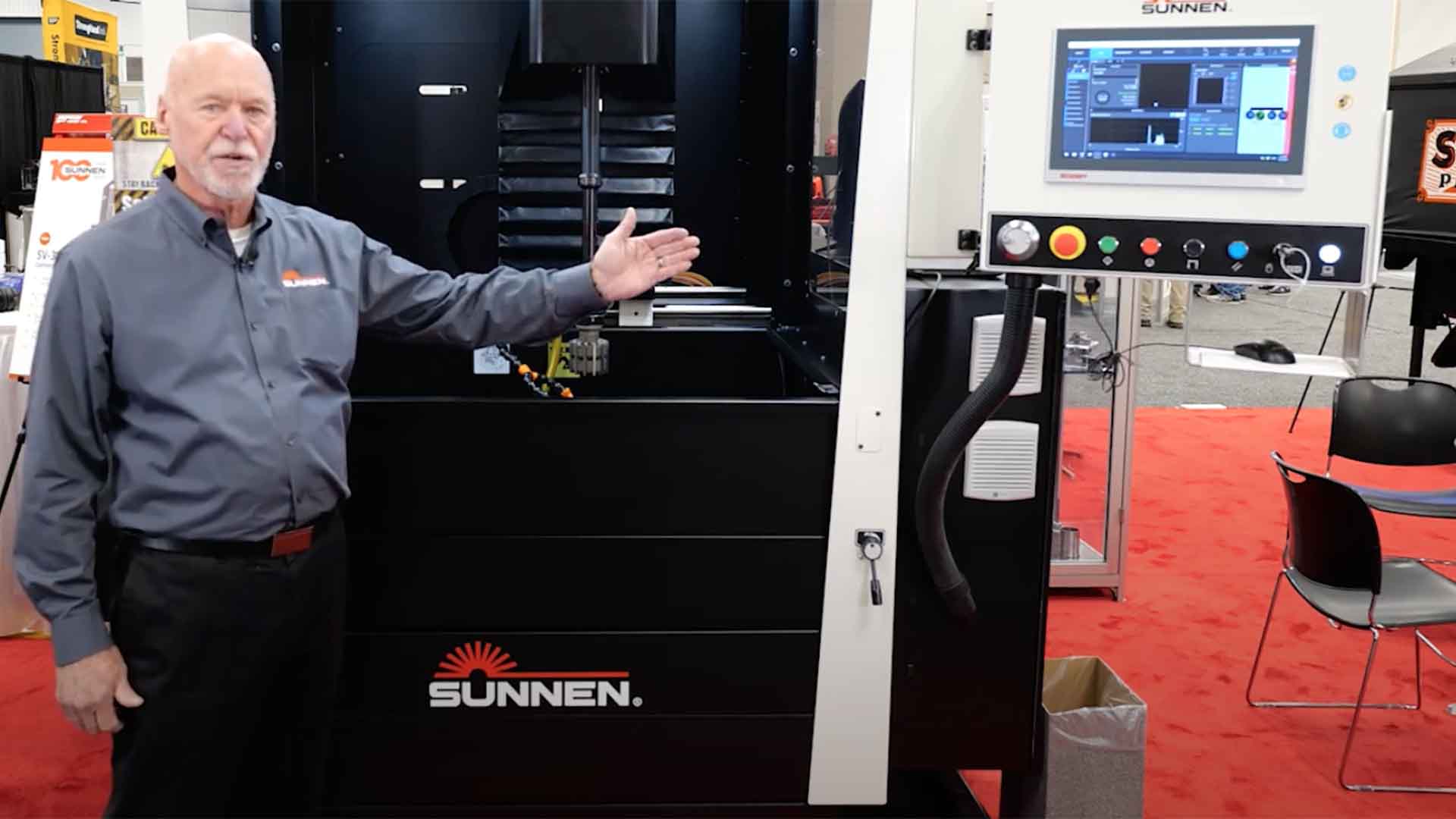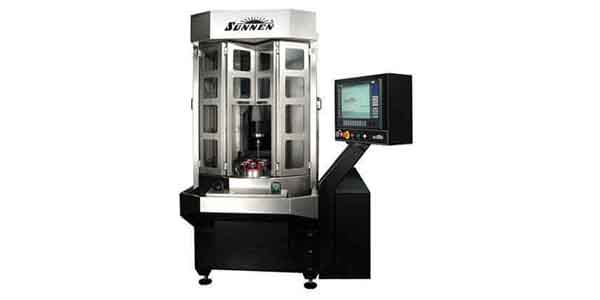
Aluminum blocks with unlined cylinders have been around a long time. One of the first (and worst) examples was the Chevy Vega engine back in the 1970s. Many of these engines burned oil from day one. The engines were cast from a high silicon hypereutectic A390 aluminum alloy that contains tiny hard particles of silicon dispersed throughout the metal matrix. The cylinder bores are then acid etched to remove just enough aluminum from the surface to expose some of the hard silicon particles. When done correctly, the exposed silicon particles provide a wear-resistant surface for the piston rings. But the Vega engine cylinders weren’t always finished properly at the factory. This was a low cost, high volume car (100 units per hour) so quality often suffered in the rush to keep the assembly line moving.
The oil consumption problem in these first generation hypereutectic aluminum blocks was also attributed to a poor cylinder head design that allowed too much oil to leak down the valve guides. The engines also had a tendency to overheat, warp and crack.
You would think the bad experience with these engines would have poisoned the idea of using unlined aluminum blocks in the future, but it didn’t. Casting an engine block from a hypereutectic aluminum alloy saves weight and cost by eliminating the need for iron liners. But it also requires a unique finishing process to create a wear-resistant bore surface for the piston rings. Manufacturers who produce “linerless” hypereutectic aluminum blocks today include Audi, BMW, Honda, Mercedes, Porsche, Volkswagen, Volvo, and Yamaha.
Most late-model engines have aluminum blocks to save weight, including most of the familiar domestic V8s such as Chevy LS, Ford 4.6L modular and 5.0L Coyote, and Chrysler 5.7L and 6.1L Hemi. Yet all of these engines have iron sleeves in the cylinders. Consequently, the cylinders in these engines can be honed using the same basic techniques and procedures that you would use to hone a cast iron block. The only difference is that you can’t remove more than about .010˝ of metal if you’re trying to recondition the cylinders.
One of the drawbacks of cast-in-liners from an engine builder’s perspective is that you can’t easily replace a liner if it is worn, damaged or cracked. You usually have to replace the block. It is possible to machine out a cast-in-place liner and replace it with a wet or dry iron liner, but it’s a lot of work and requires expensive modifications to the block. It’s usually faster, easier and cheaper to simply replace the block.
Oil Burners
Another late-model aluminum engine with cast-in-place iron liners is the 2.4L four-cylinder that GM has used in the Chevy Equinox, GMC Terrain and Buick LaCrosse, Regal and Verano. Like the Chevy Vega engines of the 1970s, the 2.4L also has a thirst for oil. GM says the problem isn’t the bore finish in the cylinders, but a ring wear problem caused by clogging of the Positive Crankcase Ventilation system, oil dilution and oil breakdown (a good reason why motorists should change their oil more often than indicated by their vehicle’s “Oil Life Monitor” service light).
GM tech service bulletin 13-06-01-003G dated February 2015 covers “excessive oil consumption concerns” on 2.4L engines in 2010 to 2013 models. GM says that if the engine is using more than a quart of oil every 2,000 miles, the rings and pistons need to be replaced. The bulletin also states that the bores in these engines do NOT need to be honed or deglazed if crosshatch is still visible and there is no excessive wear or other damage.
If an engine is using a quart of oil every 2,000 miles, it has a serious oil consumption problem. A late model engine with a proper bore finish, good ring seal and no other problems should certainly use less than a quart of oil between recommended oil change intervals, which today may range from 5,000 to 7,500 to 10,000 miles or more depending on the application. If an engine is using more oil than this, and there are no gasket leaks, seal leaks or valve guide problems, the excessive oil consumption is likely due to a bad bore finish, severe bore distortion and/or poor ring seal.
A number of late model import vehicles with aluminum engines (some with iron liners, some without) have a bad reputation for using too much oil. Excessive oil consumption seems to be more common with the European auto makers than the Asia auto makers (although Honda and Toyota have both had some oil consumption issues with certain engines).
Audi, BMW and Subaru have said that one quart of oil consumed every 1,000 to 1,200 miles is “normal” for certain engines, and burning a quart every 600 to 700 miles is “acceptable.” Acceptable to whom? Certainly not the vehicle owner. Those kinds of numbers may have been acceptable back in the 1950s and 1960s, but not in today’s highly stressed, high output engines.
If you built a stock replacement engine that sucked a quart of oil every 1,000 miles, how long do you think it would be before your customer would call you up, tell you off and demand his money back? A quart of oil consumed every 1,000 miles in a high revving race engine might not be a big deal, but it certainly would be in a stock replacement motor.
Get It Right The First Time
Proper bore finish and ring seal are absolutely essential to prevent excessive oil consumption, comebacks and unhappy customers. Whether you are honing an aluminum block with iron liners, a hypereutectic aluminum block with no liners, or an aluminum block with some type of hard nickel coating in the cylinders (such as Nikasil, Alusil, etc.), you have to know what you’re working with so you can use the appropriate honing procedures that will achieve the desired bore finish.
A good bore finish is one that requires minimal break-in, provides a flat, relatively smooth, wear resistant surface for the rings to glide over, with adequate crosshatch or pits to retain oil for ring lubrication. The cylinders also have to be round, straight up and down and with as little bore distortion as possible so low-tension piston rings can seal against them.
A three-step “plateau” honing procedure is usually recommended to reduce ring break-in time and initial ring wear in aluminum engines with iron liners or sleeves. Plateau honing will produce a bore finish that is similar to a “broken in” cylinder. The rings will seat quickly and experience minimal wear when the engine is started.
Plateau honing procedures can vary according to the application and type of rings used, but a general procedure goes as follows:
1. Use #220 or #280 grit stones to hone the bores to size and create crosshatch.
2. Switch to finer grit stones (#400 or #600) and hone again to shear the peaks off the microscopic ridges in the bore. This should leave a broad, flat surface to support the rings with adequate valley area to retain oil.
3. Sweep the cylinders a few strokes with a brush or plateau honing tool to remove residual torn and folded metal.
Once a plateau finish has been achieved, scrub out the cylinders with hot, soapy water and a brush to remove residual honing material and metal debris from the bores.

Honing Hypereutectic Aluminum Blocks
To produce a good finish in a hypereutectic aluminum engine block with no liners, you have to remove a small amount of aluminum from the bores to expose the hard silicon particles. The silicon particles should protrude about .00002˝ to .00004˝ above the surface and cover about 80 percent of the bore area. This will provide a good wear surface for the rings to ride against the hard silicon particles and not the aluminum bore.
In the old days, this was done on the Vega engines by honing to oversize with conventional abrasives, then lapping the bores with a special abrasive paste and felt honing pads. The job could be done with a portable honing tool and drill, or a honing machine.
Today, the same thing can be done using diamond stones, CBN or conventional abrasives. The objective is to produce a smooth, mirror-like bore finish, then to “rough” the surface slightly with special elastomer-bond abrasives using light pressure (less than 5 lbs. per square inch) to expose the hard silicon particles.
The first honing step is to hone the bores using conventional or diamond abrasives to achieve a surface finish of 19 microinches RA or less.
The second honing step is to use a fine abrasive (conventional or diamond) to remove only .0001˝ of aluminum to achieve a finish of 3.9 microinches RA or less. Honing oil can be used on the first two steps, but should NOT be used for the final step.
The final “exposure” step uncovers the hard silicon particles by removing the surrounding aluminum. This requires the special elastomer bond abrasives mentioned earlier. This step takes about one-and-a-half minutes per cylinder and removes only about .00002˝ of aluminum. The elastomer bond abrasive is flexible so it bounces over the hard silicon particles as it scrapes away the softer aluminum around the particles. The flexibility of the abrasive also allows it to conform to small bore distortions as it dampens and spreads the force across the surface. This allows it to remove aluminum uniformly around the cylinder as it exposes the silicon particles.
How do you know if you’ve done the job correctly? You can wait to see if your customer complains that his engine is burning oil, or you can verify the surface finish before the engine leaves your shop by using a profilometer to measure the finish in each bore.
If you check the bore finish before the final exposure step that used the flexible abrasives, the surface finish should be 3.9 microinches or less (mirror smooth). After the final exposure honing step, the surface should read rougher than before because the particles of silicon have been exposed and are poking up above the surrounding aluminum. You may have to make half a dozen or more traces with the profilometer before the tip encounters a silicon particle and registers a sharp peak (RpK). A good reading would be a peak that is 0.5 to 1.0 microns above the surrounding surface.
If the profilometer fails to detect any peaks, or the peak readings are less than 0.5 microns in height, repeat the final honing step to remove more metal and expose more of the silicon particles.
Plasma Sprayed Bores
Automakers have been experimenting with various types of high temperature plasma sprays to hard coat cylinder bores. This can be done with various metal alloys are well as powder metal. Aluminum/silicon hard coatings can also be applied to cylinder bores with a laser etching process.
The advantage with these new technologies is the potential to be faster than acid etching bores and dropping the engine in a bath to apply a hard coating such as Nikasil, Alusil or some other proprietary coating material. A sprayed on bore coating is also better than using cast-in-place or press fit iron liners because liners add to the bulk and weight of the block.
High-tech coatings also have some disadvantages. One is that they require specialized equipment to apply the coating (and to reapply the coating if it is damaged or worn). Cost, however, remains the biggest disadvantage. The cost to plasma coat engine cylinders at the OEM level is $3 to $5 per bore compared to $1.50 to $2 per bore for conventional iron liner or sleeves. Nikasil is even more expensive, costing $5 to $10 per bore depending on volume. Alusil is even more expensive.
For now, most engine builders don’t have to worry about how to hone and refinish plasma sprayed cylinders in aluminum blocks because they are not in large scale mass production – at least not yet.
Ford introduced a Plasma Transfer Wire Arc coating technology in 2011 for its GT500 Shelby Mustang 5.4L 356 alloy aluminum block. The coating allowed Ford to get rid of the engine’s iron liners and save nearly 9 lbs. of dead weight. The same plasma coating technology is being used on the cylinders in the 2016 Mustang Shelby GT350 5.2L V8. Nissan is using a similar process on its GTR turbo V6, and Caterpillar is spraying many of its wet diesel liners to reduce friction and wear.
Experts predict that as costs come down, we’ll see more widespread use of plasma and laser coatings in production engines. Friction-reducing plasma spray coatings have also been used in racing engines. In many racing applications, bores are diamond honed after being sprayed to achieve an ultra-smooth finish. This reduces friction for more power and also reduces wear so blocks last longer under grueling race conditions. Many of these coatings require a hard coating on the top piston rings (such as PVD CrN).
If an engine with cylinders that has been plasma coated needs to be reconditioned at some point, the original coating can be honed off the cylinder walls so the surface can be prepared to accept a new coating. The new plasma coating is then applied and allowed to cool, followed by diamond finish honing to recreate the ultra smooth surface.














